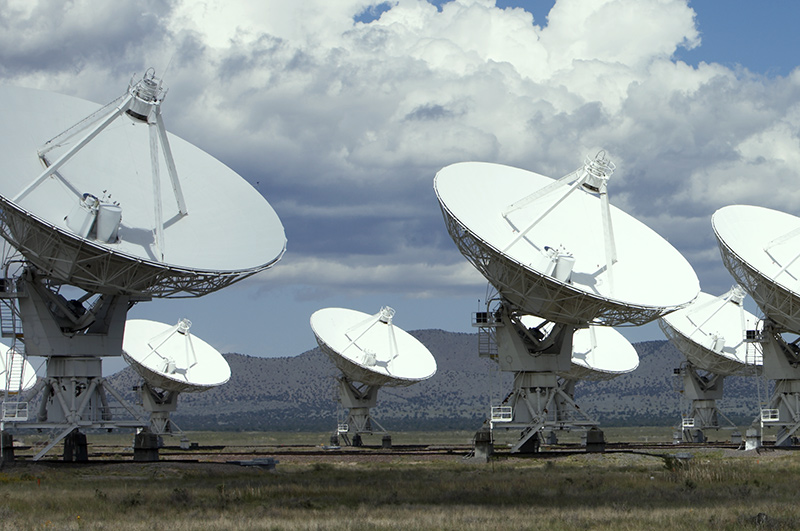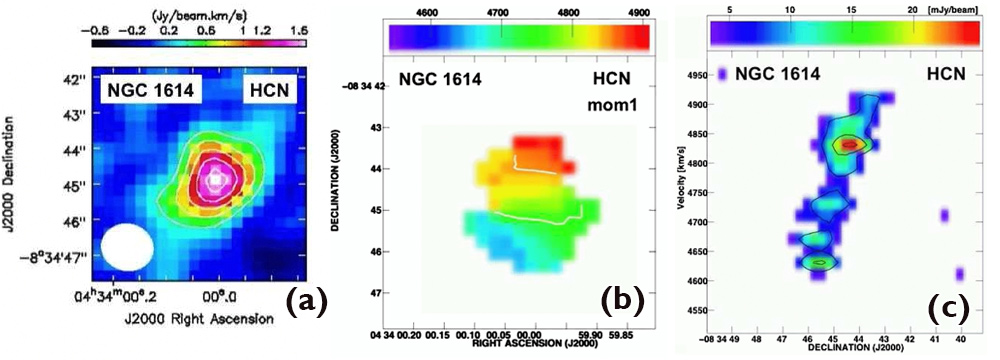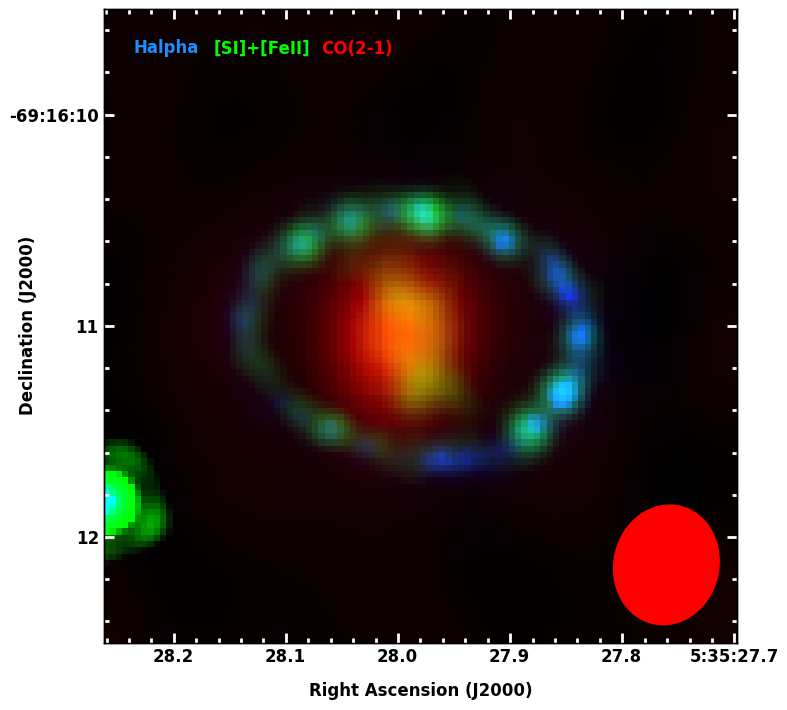NRAO eNews
Volume 6, Issue 10
September 9, 2013
NRAO eNews
Volume 6, Issue 10 • September 9, 2013

Upcoming Events

The Galactic Center: Feeding and Feedback in a Normal Galactic Nucleus
Sep 30 - Oct 4, 2013 | Santa Fe, NM

VLA Sky Survey Workshop
Jan 05, 2014 | National Harbor, MD

NRAO Town Hall
Jan 07, 2014 | National Harbor, MD
2014 Jansky Fellow Program Announcement
The National Radio Astronomy Observatory (NRAO) announces the 2014 Jansky Fellowship Program which provides outstanding postdoctoral opportunities for research in astronomy. Jansky Fellows formulate and carry out investigations either independently or in collaboration with others within the wide framework of interests of the Observatory. Prior radio experience is not required and multi-wavelength projects leading to a synergy with NRAO instruments are encouraged. The NRAO also encourages applications from candidates with interest in radio astronomy instrumentation, computation, and theory.
Appointments may be made for positions at any of the NRAO sites: Socorro, NM; Green Bank, WV; and Charlottesville, VA. Jansky Fellows are also encouraged to spend time at universities working with collaborators during the course of their Fellowship. In addition to appointments at NRAO sites, non-resident Jansky Fellowships may be offered for appointments that are hosted at a university within the United States. Frequent and/or long term visits to NRAO sites are encouraged. Split Fellowships with time spent at NRAO and a university within the US are permitted.
The starting salary will be $63,000 per year with appointment duration of two years, and possible renewal for a third. A research budget of up to $10,000 per year is provided for travel and computing requirements. Fellows are eligible for page charge support, vacation accrual, health insurance coverage, and a moving allowance. In addition, up to $3,000 per year is provided to non-NRAO institutions hosting Jansky Fellows to defray local institutional costs.
Note that the match between the host university and the candidate's research program is an important factor in the selection process. Also, appointments of more than one Jansky Fellow at a single external institution at a given time are discouraged. A list of blocked institutions for 2014 can be found on our website.
The purpose of the program is to provide an opportunity for early career scientists to establish themselves as independent researchers so that they may more effectively compete for permanent positions. The placement of Fellows at institutions other than the NRAO will help foster closer scientific ties between the NRAO and the U.S. astronomical community. The NRAO Postdoctoral Symposium is held annually to ensure close contact among all Observatory Fellows and the NRAO.
Candidates must receive their PhD prior to beginning a Jansky Fellowship appointment. The deadline for applications is Friday, November 1, 2013. The deadline for letters of recommendation is Friday, November 8, 2013. Award offers will be made by February 10, 2014, with the Fellowships normally expected to begin September 2014.
For further information and to apply, please visit our Careers Page. Please combine into one PDF file and attach to your NRAO application a cover letter, curriculum vitae, publications list, summary of previous and current research, and a research proposal.
The NRAO is an equal opportunity employer (M/F/D/V).
VLA Sky Survey Call for White Papers

[click to enlarge]
The NRAO announces an open call for community white papers on the VLA Sky Survey (VLASS) concerning survey science goals, techniques, development areas, and overall design. As announced in the 11 July 2013 NRAO eNews, the VLASS initiative will explore the science and technical opportunities of a new centimeter-wavelength survey using the recently upgraded Karl G. Jansky Very Large Array.
A community-led Survey Science Group (SSG) will define the science program and key components of VLASS. The NRAO, along with the SSG, will develop the technical design of the survey and implement it on the array.
As part of the SSG process, a public workshop will be held from 10:00 a.m. to 4:30 p.m. on Sunday 5 January 2014 at the upcoming 223rd AAS meeting in Washington, D.C. This workshop is open to all interested community members, and will kick off the SSG activities. Community white papers submitted for the VLASS will form the basis for discussion and presentations at the January AAS Workshop. Individuals or groups interested in attending and speaking at the workshop are strongly encouraged to submit white papers by 1 December 2013, to allow ample time for inclusion in the workshop.
For instructions on how to submit white papers, including guidance on content and formats, go to the VLASS website: https://science.nrao.edu/science/surveys/vlass
All submitted white papers will be made public on the website, and links will be provided there to a SSG discussion forum to allow you to participate in the VLASS process, and to generate, explore, and evolve ideas for the VLASS.
Nearby Massive Galaxy Mergers

[click to enlarge]
Massive galaxy mergers in the local Universe are observed to have high star formation rates, and often show evidence of having Active Galactic Nuclei (AGN). The activity in these galaxies is often compact, and often obscured by dust, restricting the diagnosis of these merger-induced energy sources to longer wavelength, high-resolution telescopes such as ALMA.
In the 2013 September Astronomical Journal, M. Imanishi and K. Nakanishi present ALMA observations of the high density J = 4-3 tracers HCN, HCO+ and HNC emitted from the z = 0.016 luminous infrared galaxy merger NGC 1614. With critical densities above 104 cm-3, these lines trace the gas that forms massive stars. The emission lines are observed to be emitted from the central ~2 arcseconds of NGC 1614 (Figure 1a). The emission shows velocity structure (Figure 1b, c). If the emission is situated in a disk, the gas traces an enclosed dynamical mass of ~ 109 M(sun) .
The peaks of the red and blue shifted line emission correspond spatially with 3.3 micron PAH, 8.7 GHz continuum and 8.4 GHz free-free emission, suggestive of the presence of active dusty starbursts. Finally, the J=4-3 line ratios of the red and blue-shifted "starburst" peaks are HCN/HCO+ < 1 and HCN/HNC > 1, similar to the J=1-0 HCN/HCO+ and HCN/HNC ratios seen for local starburst-dominated galaxies.
ALMA Project Status

Figure: ALMA has identified CO and SiO in the SN 1987A inner ejecta. The C/O clumps contain at least 0.01 M⊙ of 12CO, an order of magnitude greater than measured in the first few years after the explosion. ALMA views the full velocity range of emission, unobscured by dust. Doppler tomography will be possible with the completed ALMA in CO and other molecules that will probe the spatial, chemical and kinetic environment within the inner ejecta. [Kamenetzky et al., 2013 ApJ, 773, 34.]
[click to enlarge]
The ALMA local staff union and the ALMA partners (represented by AUI) signed a new two-year employment agreement on 7 Sep, ending the recent strike. Congratulations to the Joint ALMA Observatory (JAO), and many thanks to Eduardo Hardy of AUI for leading the negotiations producing this important outcome. Operations will restart over this week, and we look forward to a restart of science activities soon. An update regarding status and progress at the ALMA Observatory in Chile is expected quite soon from the JAO.
ALMA Construction is nearly finished. The 65th, or next-to-last, antenna was conditionally accepted by the ALMA Project from the contractor on 28 August. The 66th and last antenna is scheduled for delivery in mid-September. All five of the nutators have now passed their site acceptance tests; commissioning of these for the total power antennas can begin. Work remains on the electrical and fiber connections to antenna foundations not close to array center. This work will continue once the ground at the 16,500-foot elevation Array Operations site (AOS) thaws in the austral spring.
The winter has brought some exceptional weather to the AOS and the Region: San Pedro de Atacama saw its heaviest snowfall in three decades on 25 August. Precipitation occurs as snow or ice at the AOS and blows rather than falls, so measurements are difficult but there have been a significant number of storms this winter.
Several Cycle 1 projects were executed in the course of software acceptance and were recently delivered to Principal Investigators. There have been eleven submissions for Director's Discretionary Time (see the ALMA Science Portal), and one was approved, observed, and delivered. A dozen additional Cycle 0 datasets have been made available this month in the Science Archive at the expiry of their proprietary periods.
Preparations continue for Cycle 2, and the Joint ALMA Observatory will soon issue a pre-announcement. Potential users are reminded to watch the ALMA Science Portal for news pertaining to progress with Cycle 1 observations, and to the announcements for Cycle 2. The actual Call for Proposals is expected in October for a December deadline. Cycle 2 science observing is expected to commence 1 June 2014.
ALMA Memo 598 was recently published: Relative Integration times for the ALMA Cycle 1 12-m, 7-m, and Total Power Arrays by B. Mason and C. Brogan. The authors derive some basic considerations relating combining synthesis observations made with different arrays, and their relation to single dish imaging. The goal is to make clear and explicit a method by which the ALMA 7-meter Array and the ALMA Total Power Array integration times can be chosen for a given ALMA 12-meter Array integration time.
A Call for ALMA Development Project proposals was released on 3 June 2013. Eight submissions were received at NRAO by the close of business on 16 August. Total requested funding exceeded that available by 1.75x. There were 32 PIs and Co-Is representing 11 institutions listed on the proposals. Five US institutions were represented, three Canadian and one Taiwanese.
An external committee is reviewing the nine ALMA Development Study proposals received in July, with the highest ranked proposals expected to receive funding. Results are expected in early October
Recent Press Releases
 |
Powerful Jets Blowing Material Out of Galaxy Astronomers using a worldwide network of radio telescopes have found strong evidence that a powerful jet of material propelled to nearly light speed by a galaxy's central black hole is blowing massive amounts of gas out of the galaxy. Read more… |
 |
Milky Way Gas Cloud Causes Multiple Images of Distant Quasar ALMA has opened another window on the Universe as astronomers successfully used the new Band 8 receivers to observe the distribution of atomic carbon in a planetary nebula dubbed NGC 6302. The receivers were developed by the National Astronomical Observatory of Japan (NAOJ). Read more… |
 |
Milky Way Gas Cloud Causes Multiple Images of Distant Quasar For the first time, astronomers have seen the image of a distant quasar split into multiple images by the effects of a cloud of ionized gas in our own Milky Way Galaxy. Such events were predicted as early as 1970, but the first evidence for one now has come from the National Science Foundation's Very Long Baseline Array (VLBA) radio telescope system. Read more… |
 |
Associated Universities, Inc., (AUI) the organization that manages the NRAO, has signed an agreement with West Virginia University to provide dedicated observing time on the Robert C. Byrd Green Bank Telescope (GBT). Under the agreement, West Virginia University will provide $1 million in financial support for the facility over the next two years. Read more… |
 |
Starbirth Surprisingly Energetic: ALMA observations give new insights into protostars While observing a newborn star, astronomers using the ALMA telescope discovered twin jets of matter blasting out into space at record-breaking speed. These surprisingly forceful molecular "winds" could help refine our understanding of how stars impact their cloudy nurseries and shape their emerging stellar systems. Read more… |
 |
Venerable NRAO Telescope Reborn as Earth-based Antenna for Orbiting RadioAstron Satellite The trailblazing 43 Meter (140 Foot) Telescope at the NRAO in Green Bank, W.Va., has been given new life as one of only two Earth stations for the Russian-made RadioAstron satellite, the cornerstone of astronomy's highest-resolution telescope. Read more…
|
 |
Newly Found Pulsar Helps Astronomers Explore Milky Way's Mysterious Core Astronomers have made an important measurement of the magnetic field emanating from a swirling disk of material surrounding the black hole at the center of our Milky Way Galaxy. Read more…
|
Career Opportunities
New Postings
Human Resources Assistant: The NRAO in Charlottesville, VA is accepting applications for a Human Resources Assistant to provide administrative and project support to the Human Resources Department in the areas of recruitment, employment, HRIS, file maintenance, new employee orientation, payroll related activities, meeting logistics and special projects.
NRAO Postdoc: The NRAO in Green Bank, WV is seeking a Postdoc to join their scientific staff. The successful applicant will have 50% of his/her time available for independent research, while 50% of his/her time will be devoted to support of the Robert C. Byrd Telescope (GBT) and GBT observers. This is a two year appointment.
Systems Administrator II: The NRAO in Charlottesville, VA is recruiting for a Systems Administrator II. The successful candidate will be a member of the Charlottesville Computing Information Services division and will support access to production Information Services (email, printing, web access, applications, Office Productivity suite and systems/access management.)
Jansky Fellow: The NRAO invites applications for the position Jansky Fellow. The purpose of the Jansky Fellowship Program is to provide an opportunity for early career scientists to establish themselves as independent researchers so that they may more effectively compete for permanent positions. This is a two-year appointment.
NAASC Postdoctoral Fellow: The NRAO in Charlottesville, VA is seeking a NAASC Postdoctoral Fellow. Applicants for this position should expect to spend 50% of their time on independent research, with the remaining time spent on developing ALMA expertise and assisting the NAASC scientific staff in the support of ALMA users. This is a two year appointment.
Technical Specialist II: The NRAO in Socorro, NM is accepting applications for a Technical Specialist II. Under general supervision from scientists and engineers, the Technical Specialist assembles, calibrates, tests, analyzes, troubleshoots and/or repairs the Digital Transmission System and Receiver modules.
Systems Administrator I: The National Radio Astronomy Observatory in Green Bank, West Virginia is seeking a Systems Administrator to support local technical and scientific staff Redhat Linux systems and assist in the development and maintenance of the GBT data archive, high performance computing systems.
Software Engineer II, Control/ObOps: The National Radio Astronomy Observatory in Socorro, NM invites applications for a Software Engineer II. The successful candidate will participate in the development of user interfaces, working half of the time on the Observatory Operations Support Software (ObOps) group, based in Garching, Germany; and the other half of this time on the Control Software group, in Socorro, New Mexico. As this position is based in Socorro, the candidate will interact directly with the Control team, but will coordinate development activities remotely with the ObOps team. The candidate is expected to participate in all aspects of the software development effort.
From the Archives
Ellen Bouton

[click to enlarge]
About this month's photo: The National Youth Science Camp (NYSC) celebrates its 50th anniversary in 2013, which is also West Virginia's 150th anniversary. West Virginia started the NYSC on its 100th anniversary. NRAO has been involved in the camps since the beginning, with tours of the Green Bank site, teaching by NRAO staff, and various scientific activities for the campers. This photo from July 1963, the camp's first year, is of the boys from the camp in front of the Jansky Lab in Green Bank. Yes, in its early years, the NYSC was for boys only. In the Archives files, there is 1972 correspondence between NRAO Director David Heeschen and American University's Mary Gray, Chair of both the Association of Women in Mathematics, and the Committee on Women of the American Association for the Advancement of Science, about correcting the gender discrimination. She quotes the description in a Time Magazine article, dated July 17, 1972, of "a unique institution called the National Youth Science Camp, where 100 of the nation's brightest 16- to 18-year-old male science students ... gather for three weeks of serious talk and relaxation." It is not clear from the Archives files exactly when the Camp was opened to women, but the 1975 photo of campers includes a significant number of girls.
From the Archives is an ongoing series illustrating NRAO and US radio astronomy history via images selected from our collections of individuals' and institutional papers. If readers have images they believe would be of interest to the Archives, please contact Ellen Bouton, ebouton@nrao.edu.

